Menus
- Travel enduros with 19-inch front wheels tested
- KTM 1190 Adventure
- Triumph Tiger Explorer XC
- Honda Crosstourer
- Yamaha XT 1200 Z Super Tenere WorldCrosser
- Moto Guzzi Stelvio 1200 8V
- BMW R 1200 GS
- MOTORCYCLE scoring
- MOTORRAD test result / conclusion
- Technical specifications
- Safeguards
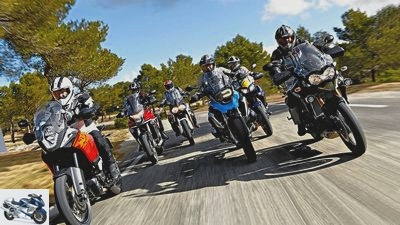
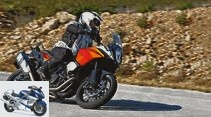
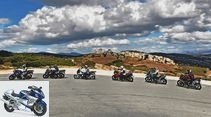
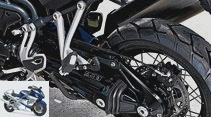
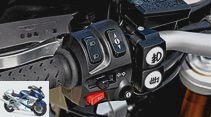
44 photos
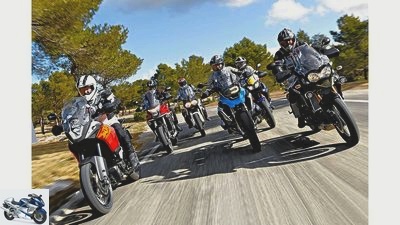
1/44
KTM 1190 Adventure, Honda Crosstourer, Moto Guzzi Stelvio 1200 8V, BMW R 1200 GS, Yamaha XT 1200 Z Super Tenere Worldcrosser and Triumph Tiger Explorer XC in the big enduro comparison test 2013.
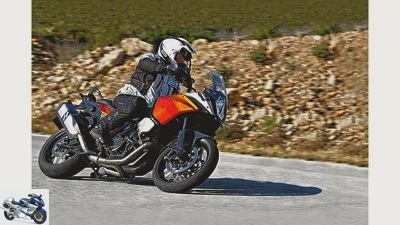
2/44
KTM 1190 Adventure. Traveling or racing? Real 147 hp meet moderately long suspension travel, only 238 kilograms and many electronic helpers.
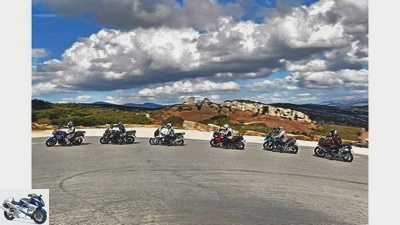
3/44
Upscale landscape and driving pleasure. With seat heights of 85 centimeters or more, wide handlebars and upright sitting positions, you get a good overview. Not only on fantastic motorcycle routes in Provence.
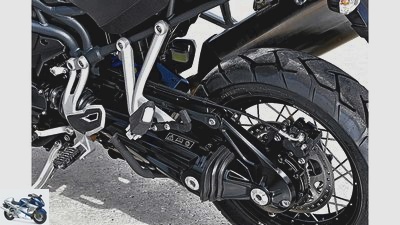
4/44
Extremely supple, low-reaction cardan single-sided swing arm. Distinguishing mark of the XC: spoked wheels.
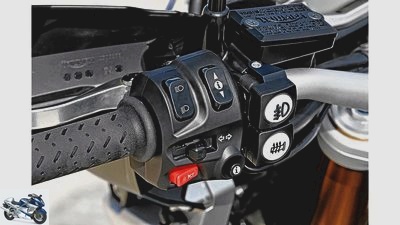
5/44
Additional headlights (and all cockpit functions) can be operated from the handlebar.
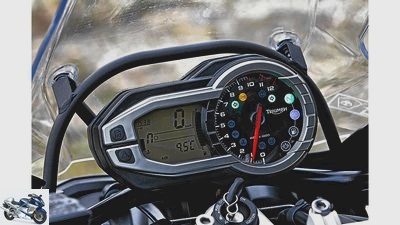
6/44
Contrast program. A coarse washer bracket and a rather thick tachometer needle meet finely chiseled LCD displays.
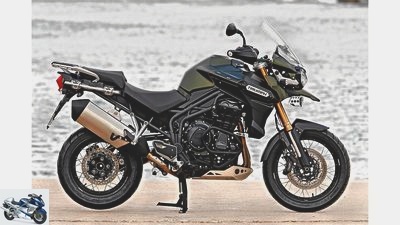
7/44
Triumph Tiger Explorer XC. A bull on wheels. With a squat front, high and wide, plus a slim rear end with a large muffler. The XC has engine protection, crash bars and fog lamps as standard.
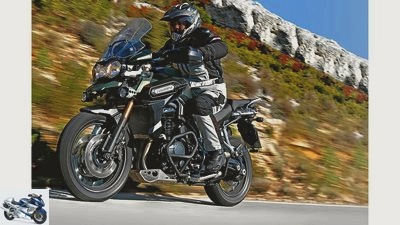
8/44
Triumph Tiger Explorer XC. Feels heavy and powerful. But also beguiling and exclusive – thanks to the three-cylinder tube and natural matt varnish.
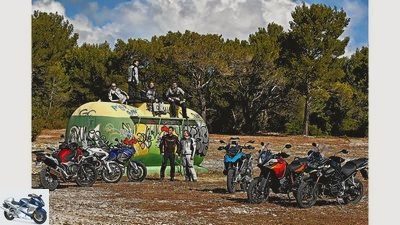
9/44
Good prospects: The 2013 vintage enduro bikes are more exciting than ever. For rough gravel passages, you need a little courage with the large, often heavy trail bikes.
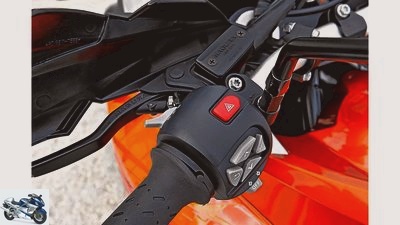
10/44
Extremely smooth clutch lever.
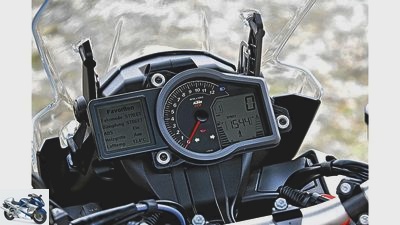
11/44
Few switches for the most extensive settings and information from the cockpit.
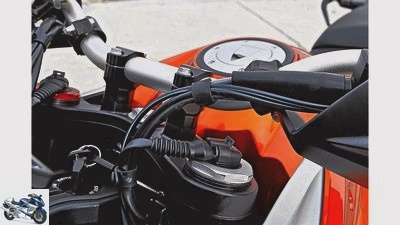
12/44
Well thought out. The handlebar can be mounted in two positions, moved further or closer to the driver. The cables on the fork show that the damping can be adjusted electronically (at an additional cost).
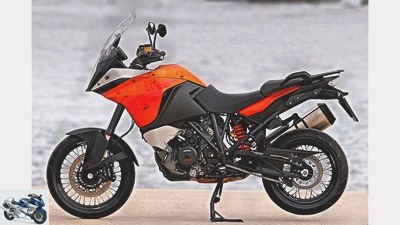
13/44
KTM 1190 Adventure: pleasing or arbitrary? For otherwise so angular KTM conditions, the new Adventure looks downright smooth. Real lightness is reflected in the delicate design.
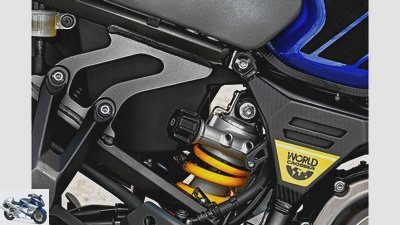
14/44
Practical handwheel on the shock absorber, bolted rear frame.
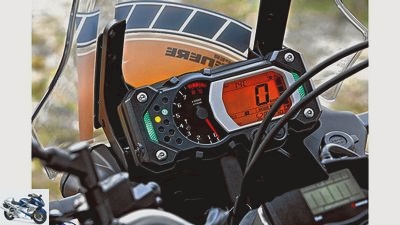
15/44
It works better. The throttle cables are somewhat in view. As with the Stelvio: no gear indicator. À la Crosstourer, the display modes can only be switched directly on the cockpit.
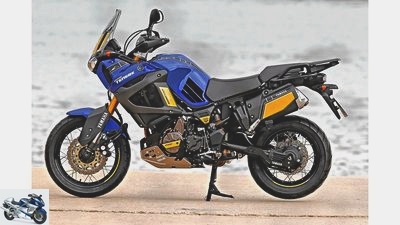
16/44
Yamaha XT 1200 Z Super Tenere Worldcrosser: Components: Real carbon for fork protectors, side panels with aluminum grilles and frame protection. Plus aluminum protectors on the final drive and rear brake.
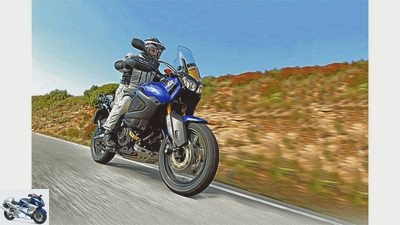
17/44
Yamaha XT 1200 Z Super Tenere Worldcrosser. Yamaha’s traditional rally colors are hard to beat. The 1200 is actually more of a good-natured buddy.

18/44
The one-armed cardan has a homokinetic joint, but no external moment support.
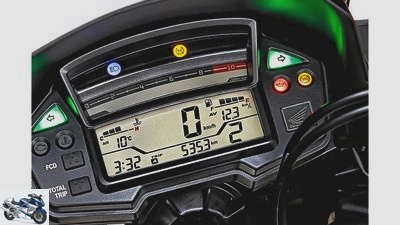
19/44
Search game: where is the tachometer? The narrow LCD light strip shows imprecisely and roughly. A Honda weakness.
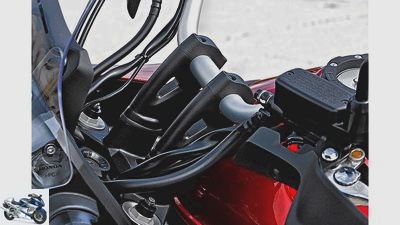
20/44
Enduro chopper: the handlebars rest on high risers. No wonder it is the highest on the test field.
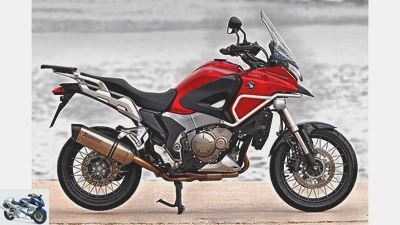
21/44
Honda Crosstourer: Own: aluminum bridge frame, built-in front, slim rear, long wheelbase, flat fork. Tubeless spoked wheels are standard, but Akrapovic exhaust and crash bars are extras.
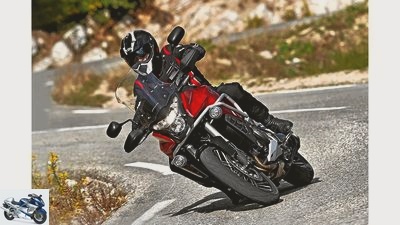
22/44
Honda Crosstourer: The V-shaped headlight says what’s going on: Here comes a V4 machine. Your high touring screen costs extra.
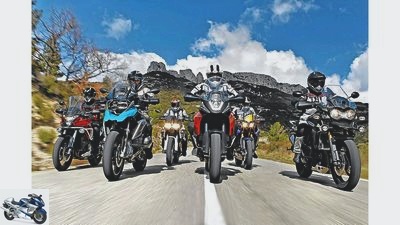
23/44
The BMW R 1200 GS wins the group test. Round concept.
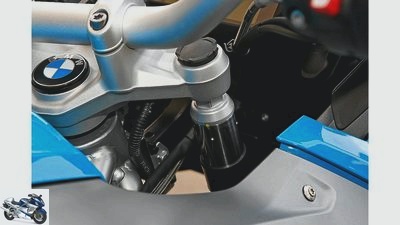
24/44
Four punch points arranged in a cross shape subsequently caulk the standpipes. For cost reasons, the forks were secured with adhesive (“Loctite”) instead of the previous mechanical caulking using punch punches. Which may not be enough. So BMW decided to go back to the original backup method to eliminate any risk.
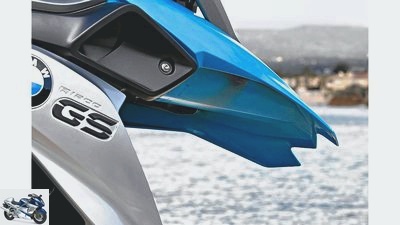
25/44
The view from the side when parking on the side stand is unpleasant: the jagged duck bill “with teeth” is not colored through. Its underside is pale, full of spray.
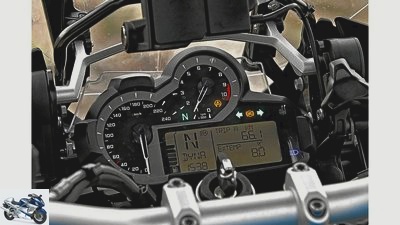
26/44
Slightly small round clocks sit above the very extensive liquid crystal display of the on-board computer.
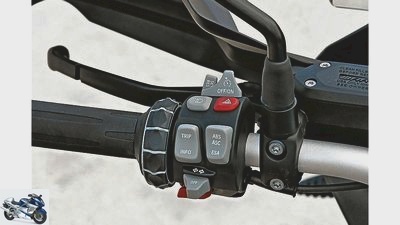
27/44
Thinker on the handlebars: clever, intuitive operating concept. With a conventional indicator switch, buttons for cruise control and a hand wheel for the optional navigation system.
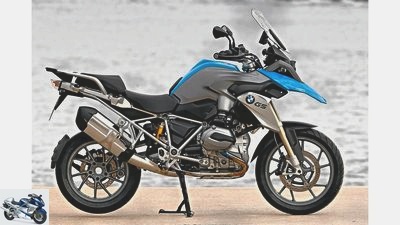
28/44
BMW R 1200 GS: familiar shapes, reinterpreted. Wiry, muscular and technoid. With cylinders flowing through from top to bottom and two well hidden water coolers (behind the silver cover). Cast wheels are standard, the steel bridge frame is new.
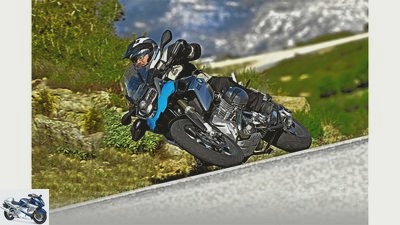
29/44
BMW R 1200 GS. Holy cow or cow in a hurry? The new GS also does everything: touring, pleasure driving and really crisp weirds like speeding.
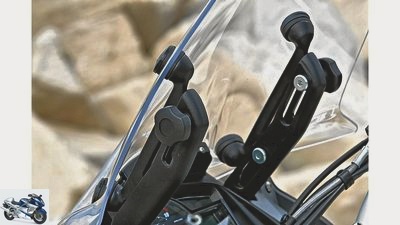
30/44
As with all four Europeans, the disc can be adjusted without tools. OK then.
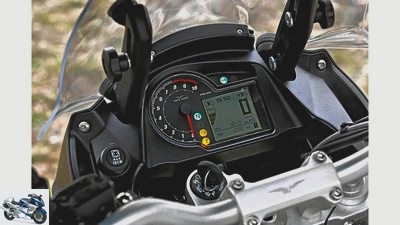
31/44
Well done. The only thing missing in the clearly structured cockpit is a gear indicator. Otherwise, the on-board computer, which can be operated from the handlebars, has a lot to report.
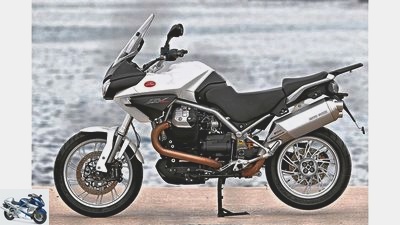
32/44
Moto Guzzi Stelvio 1200 8V: Gentle giant. Dominantly thick elbow boas flicker out of the single air-cooled cylinders. XXL silencer on the left, mighty single-sided swing arm, filigree cast wheels.
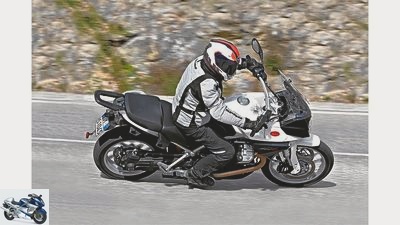
33/44
Moto Guzzi Stelvio 1200 8V. The supertanker (32-liter fuel drum!) Offers comfortable seats and its very own V2 charm. Its precision in corners is great.
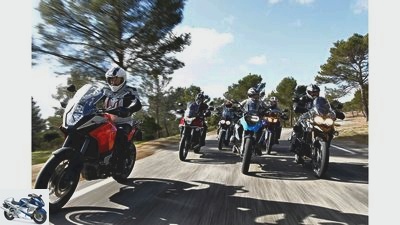
34/44
Travel enduros in the test – part 1.
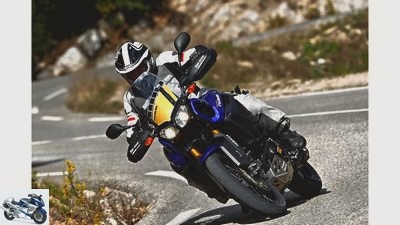
35/44
Travel enduros in the test – part 1.
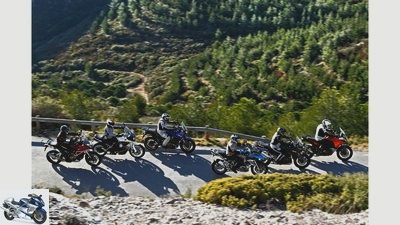
36/44
Travel enduros in the test – part 1.
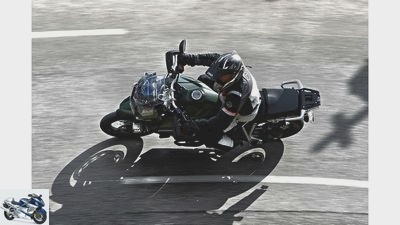
37/44
Travel enduros in the test – part 1.

38/44
Travel enduros in the test – part 1.
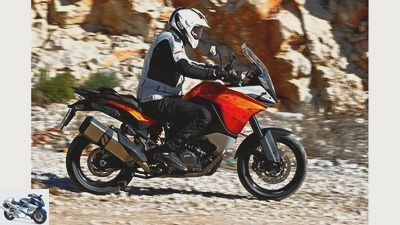
39/44
Travel enduros in the test – part 1.
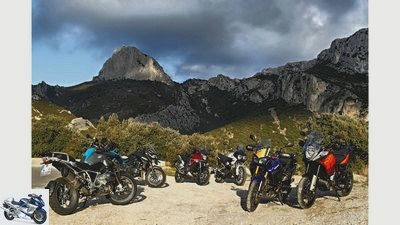
40/44
Travel enduros in the test – part 1.
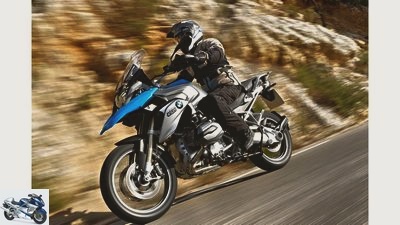
41/44
Travel enduros in the test – part 1.
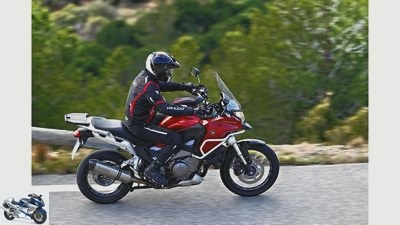
42/44
Travel enduros in the test – part 1.
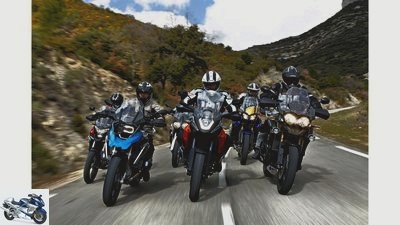
43/44
Travel enduros in the test – part 1.
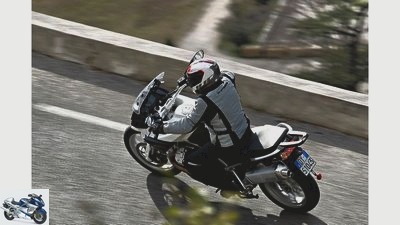
44/44
Travel enduros in the test – part 1.
Travel enduros in comparison test part 1
Travel enduros with 19-inch front wheels tested
After almost 33 years of GS history and 90 years of BMW boxers, the renewed 1200 series faces all competitors with 19-inch front wheels. KTMs in particular also make completely new, 150 hp 1190 Adventure as a bunny legs for the Bavarian hedgehog?
GLarge travel enduros are the most popular type of motorcycle in Germany and are also very successful in France and Italy. Because they embody many motorcycles in one, they can do everything: bolt crisply over Alpine passes, go on tour with two people and luggage or carry them confidently through everyday life. They are there when you just have to get out, want to leave everything behind. They keep the longing simmering. You could if you wanted to. Or should. Just drive, just live.
Buy complete article
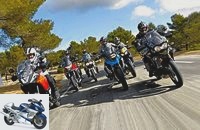
Travel enduros in comparison test part 1
Travel enduros with 19-inch front wheels tested
R 1200 GS the direction of march. She shaped the recipe for this segment: around 1200 cubic meters, around 110 hp and more, and preferably cardan. The whole thing garnished with ABS and traction control, large individual silencers, on-board computers and adjustable windows. In 2013, BMW’s trendsetter is now completely redesigned with a water-cooled 125 HP engine and improved chassis. The challengers are struggling to finally win the race for buyers’ favor and test victories. Can the remodeled GS keep the competition at bay??
KTM 1190 Adventure
Visually, the new KTM 1190 Adventure is a dignified, almost delicate enduro tourer. It looks smooth and compact, stands sturdy on its 19- and 17-inch wheels, 120 millimeters wide at the front and 170 millimeters at the rear. The same tire formats as on the BMW R 1200 GS. Only 190 millimeters of suspension travel, as much as the Yamaha, is ready for all kinds of adventures, 20 less than the old 990. Despite the 23 liter tank, the second largest of the sextet, the Adventure is less reminiscent of ParisDakar and more of the 990 SMT. But be careful, she’s a wolf in sheep’s clothing: the “tamed” heart of the super sports car RC8 beats in the 9.8 kilo tubular space frame.
KTM 1190 Adventure. Traveling or racing? Real 147 hp meet moderately long suspension travel, only 238 kilograms and many electronic helpers.
The fiery 75-degree V2 wakes up with a bark at an idle speed of a good 2000 rpm. The lever of the servo-assisted clutch can be pulled as light as a feather, and first gear slips into it with precision. The two-cylinder with the four spark plugs hangs delicately on the electronic throttle, almost without disturbing load changes. At speeds below 3500 rpm, the ultra-short stroke (huge 105 slipper pistons!) Does not run really smoothly in the upper gears. It should be 80 km / h in the sixth. Nevertheless, thanks to the short gear ratio, the KTM 1190 Adventure delivers top torque values, a whopping 7.2 seconds from 60 to 140 km / h.
Mild follows wild: the V2 grumbles acoustically up to the 6000 mark. Above it, the engine storms towards a real 147 hp at 9600 tours. Shift quickly, because 100 revolutions later the rev limiter pinches. Promised Vmax of the KTM 1190 Adventure: a brutal 250 km / h. Nothing comes from nothing: In addition to the Honda, the gasoline consumption is the highest, from 5.6 liters per 100 kilometers. Four different driving modes combine throttle response, power output, traction control and ABS regulation.
Full power is available for “Sport” and “Street”, 100 hp for “Rain” and “Offroad”. In the off-road mode, the V2 responds very directly as in “Sport”. All settings can also be freely combined. Only when the control light flashes frantically in the cockpit in “Street” mode reveals how much power the lean-dependent traction control has to dispense with so that the rear wheel stays on track. The “Sport” mode offers the best possible acceleration with controllable rear wheel slip. If you switch off the traction control completely, wild drifts and wheelies are the result, even in third gear. A real superbike, the KTM 1190 Adventure. The electronic helpers always give you the choice, safe or sporty.
For a surcharge of EUR 800 on the basic price of EUR 13,995, the electronic chassis from WP is on board – in a package with a main stand and tire pressure control. With the KTM 1190 Adventure, good feedback meets rather tight coordination. Comfort? Goes so. The finely adjustable Brembo brakes with the latest Bosch combi ABS have the light 238-kilo device under control. The braking performance is great. The handbrake lever also actuates the rear wheel equipped with lift detection. In off-road mode, the ABS only regulates the front and allows a locking rear wheel.
The stiff, non-adjustable steering damper causes a slight wobble around the longitudinal axis when creeping, while brisk driving in smooth curves it dilutes the line. KTM had already correctly adjusted the tight steering head bearing since the first test. Now it’s better, but not ideal: the KTM 1190 Adventure doesn’t exactly get to the point. Such a sharp iron should drive more precisely, more jagged. The KTM does not make scalpel-like sickle cuts through the curve radii. And this despite the fact that the 1190 rolls on Continental’s famous new development, the TrailAttack 2.
There are tons of well thought-out details. Daytime running lights with brightness sensor for example. When removing the rear wheel, the drive chain can be placed on spikes on the filigree swing arm. Handlebars and footrests are twofold, the disc is continuously adjustable. The seating comfort is okay, despite the hard seat and the narrowest handlebars. Long, 15,000-meter maintenance intervals make long-distance travel suitable. But the true potential of the new KTM 1190 Adventure can hardly be found on a leisurely stroll. And for the lure of the desert there is also the R version: with longer suspension travel (220 millimeters each), large, narrow enduro wheels (21/18 inches) and everything else you need for a great adventure.
Triumph Tiger Explorer XC
Long-distance trip? Adventure? Triumph is promoting the XC version of the Triumph Explorer, which was only introduced in 2012. From a purely visual point of view, the martial “cross-country” variant makes it difficult to discover. With crash bar set, additional headlights and hand protectors. Plus with a sturdy aluminum oil pan protector, not plastic like the KTM 1190 Adventure. The engine, drive train and chassis are unchanged from the standard Explorer. While these have cast rims, the Triumph Tiger Explorer XC rolls on aluminum rims with steel spokes. Tubeless tires sit on them – as with all competitors. But in contrast to Triumph’s 800 Tiger XC, the 1200 doesn’t have a 21-inch model in front.
Triumph Tiger Explorer XC. Feels heavy and powerful. But also beguiling and exclusive – thanks to the three-cylinder tube and natural matt varnish.
The famous three-cylinder pampers with a very even power output. The electronic throttle and cardan respond nice and smooth to gas, gas to. Quite supple. The two-stage traction control and cruise control on the Triumph Tiger Explorer XC are sensitive. Well done. The sound is inimitable, a six-cylinder cut in half: “vroouum“.
Great performance (over 130 hp!) Meets low consumption (4.7 liters) – which, like the BMW R 1200 GS, puts the small 20-liter tank into perspective. Together with Honda’s V4, the Triumph Tiger Explorer XC is the easiest to drive. Deepest speed basement? No problem for the broadband feel-good engine. The triplet is good at idling up to over 9000 tours. Downside? The long shift path between first and second gear.
The gear lever protrudes too far from the factory. To shift up, the foot has to get off the notch, which touches down relatively early. The Triumph Tiger Explorer XC circles corners with little feeling from the front wheel. The responsiveness and tuning of the 46 upside-down fork should be better. Soft springs, damping too tight. Because only the preload can be adjusted, a perfect setting is not possible. At the exit of the curve, the 277-kilogram bull pushes outwards, he loves wide arcs. It is important to grab the adjustable handlebars with force to keep them in line. Especially since the XC stands up noticeably when it comes to the effective front brake. The required hand strength is high, the ABS controls sensitively. 16000 service intervals are groundbreaking, the top equipment of the XC is brilliant. It costs 14,950 euros, 1200 more than the standard Explorer.
Honda Crosstourer
There was never a V4 travel enduro until 2012. From the largest cubic capacity of the field, a stately 1237 cm3, real 121 hp and 118 Newton meters grow. The smoothly running four-cylinder starts evenly and powerfully at under 3000 rpm. Accompanied by the subtle purr from the optional Akrapovic exhaust. Between 5000 and 6000 the pressure is brutal, the Honda Crosstourer lifts the fatest torque of the sextet. But the thirsty V4 with the Big Bang firing order does not convert this into sovereignly superior draft.
Honda Crosstourer: The V-shaped headlight says what‘s going on: Here comes a V4 machine. Your high touring screen costs extra.
The final translation is too long for that, although the speed cutter cuts off the juice at a real 209 km / h. Plump regulates the disengageable slip control, takes a long time after an intervention before it releases full power again. In contrast to that of Triumph or BMW and the two-arm of the Guzzi, the cardan single-sided swing arm does not have torque support. The Honda Crosstourer feels heavy when pushing and maneuvering. The center of gravity is high, the weight is enormous: around 280 kilograms including accessories. “A big whale,” says Bertrand, our French colleague.
The uncomfortable, one-piece bench is the only one that is not height adjustable. The sitting position turned out to be strangely passive, not typical for Honda: It spreads its legs wide, although the two rear cylinders are closer together than the pair in front. The handlebar rests high – like on a custom bike. Should you ride standing up all the time? Other nicks: Jacking up on the main stand, which unfortunately has to be paid for, takes strength. The standard equipment of the Honda Crosstourer was poor: the on-board socket under the seat costs 98 euros. The “road enduro” (Honda) with its low payload of 186 kilograms lacks an engine guard. But the brakes shine. Partly integral, the pedal also pinches at the front. Their Pirelli tires are light-footed and make the balloons.
Your chassis has the smallest suspension travel, but works well. The fork stuck in a bit with rapid impulses, the shock absorber helps when the load is completely closed rebound stage damping. The small tropic has a confidence-building effect. Where does the Honda Crosstourer shine? Well, the optional touring screen provides the best protection alongside that of the BMW R 1200 GS. The three-year guarantee is an example. And for a surcharge of 1,000 euros, the mighty V4 engine is also available with Honda’s unique double clutch.
Yamaha XT 1200 Z Super Tenere WorldCrosser
They are colorful, the rally factory colors of Yamaha‘s XT 1200 Z Super Tenere WorldCrosser, blue and gold in contrast with jet black. Fancy. You like to lounge in the plush armchair of an enduro bench, you feel very much inside, perfectly integrated into the motorcycle with the low footrests. For small pilots, the Yamaha is the first choice among the really big ones.
Yamaha XT 1200 Z Super Tenere Worldcrosser. Yamaha’s traditional rally colors are hard to beat. The 1200 is actually more of a good-natured buddy.
The in-line twin with 270 degree crank pin offset imitates a 90 degree V2. He taunts discreetly from the clumsy black painted steel muffler, the only base muffler of all six machines. In the lower speed range, the engine does not feel like a full 1200 cubic meters. Since he acts a little tired and slow to start. Just cozy.
A Suzuki V-Strom 650 pushes more powerfully out of the bends. No, the Yamaha XT 1200 Z Super Tenere WorldCrosser does not uproot trees, it only becomes more lively from the 5000 mark, especially in the sportier S-Mapping instead of the more touristy T-mode. The twin looks a bit tough when turning out. Especially since the two-cylinder is throttled in the lower three gears. Doesn’t Yamaha trust the three-stage adjustable traction control itself? It works well. Below, only other software offers a lot more punch. But if you have never driven the other candidates, you may not miss anything. Even without the really big emotional kick.
The low-reaction cardan shaft is great, and the well-balanced chassis of the Yamaha XT 1200 Z Super Tenere WorldCrosser is impressive. As with the BMW R 1200 GS, the Honda Crosstourer and the KTM 1190 Adventure, the rear frame is screwed on. Delicately appealing, easy-to-swallow spring elements take the horror out of even the deepest potholes. Upscale seating meets just as much driving and suspension comfort. The medium-weight 269 kilo Worldcrosser is not a handling miracle. But he circles bends safely and securely. The XTZ trusts Metzeler Tourance EXP with the special code “C”. This means that the Yamaha is much less positioned than the Triumph with “M”. After all, Ex-R1 stoppers bite extremely powerfully and easily dosed on the wave brake discs, four-piston calipers with two pairs of unequal pistons each. Top!
The ABS on the rear wheel regulates a bit trampling – kalack, kalack, kalack. The wind protection should be better, the pane is far away. As with the Honda, you have to stop and use tools to adjust it. Hello Japan, already awake? Otherwise the Yamaha is a great touring motorcycle, an XXL hiking enduro. Its 22.6 liter tank allows a range of up to 450 kilometers. Ex-MOTORRAD employee Mathias Heerwagen drove 55,000 kilometers from Alaska to Tierra del Fuego on a Super Tenere in nine months without a breakdown.
Moto Guzzi Stelvio 1200 8V
Now that the BMW R 1200 GS is water-cooled, only the Moto Guzzi Stelvio 1200 8V holds up the flag of traditional air-cooling. Modern and yet rustic, the Stelvio only contains as much electronics and complex technologies as absolutely necessary. No other engine growls and grumbles as nice and bassy as the 90-degree V2. Beguiling and sensual charm. When accelerating while standing, the Guzzi happily turns to the right and then back to the left. A greeting from the crankshaft rotating across the direction of travel. It’s wonderful when the exposed cylinders tickle and roar synchronously to the left and right.
Moto Guzzi Stelvio 1200 8V. The supertanker (32-liter fuel drum!) Offers comfortable seats and its very own V2 charm. Its precision in corners is great.
The bull engine of the Moto Guzzi Stelvio 1200 8V is not exactly greedy, it is a bit sluggish on the gas. Fits the character. After a small torque hanger between 3000 and 4500 tours, the comfortably vibrating V2 comes out of the push harder. It is a pleasure to squeeze out the engine with the longest stroke. Until the “Quattrovalvole” (four-valve engine) delivers a full 106 hp. Despite long shift travel, the shift feel is full, all gears lock safely. Load change reactions are noticeable, yes. And the well-functioning clutch needs a little force when stopping and going. Everything is just real. Fantastically well balanced, the gentle giant swings really round through the most angled combinations of curves. The enduro-look tourer can be optimally directed using the widest handlebar. Held evenly under tension, this good-natured bear implements steering commands accurately one to one. Good-natured and neutral, without any need to set up. More precise than the KTM, compliments! The name Stelvio, Italian for Stilfser Joch, seems to have been born with a willingness to curve. Longitudinal crankshaft and the second shortest wheelbase (after the GS) make it easy to use. After all, the colossus weighs an enormous 282 kilograms with a full 32-liter fuel drum. But you only notice that when you push it.
ABS brakes and suspension elements are suitable. The 45 mm upside-down fork responds well when the adjuster for compression and rebound damping is turned up by 1.25 turns each. A hand wheel hydraulically preloads the shock absorber for the load – as on Honda, Triumph and Yamaha. A passenger sits most comfortably on the Moto Guzzi Stelvio 1200 8V. The thickly padded driver’s seat is also good for mammoth stages. After the BMW R 1200 GS, the Stelvio disc is the easiest to adjust. The rear frame is not welded very easily – as on the Triumph Tiger Explorer XC. Positive: the gear lever and brake pedal can be adjusted using an eccentric. The Stelvio does not have heated grips on cool mornings. But emotionally, as an alternative to the BMW R 1200 GS, it makes your heart warm.
BMW R 1200 GS
The previous air / oil-cooled BMW R 1200 GS, christened with the factory code “K 25”, was BMW’s bestseller, the best-selling large travel enduro in the world. Nevertheless, the air / water-cooled “K 50”, newly designed down to the last screw, looks very familiar. Welcome Home. Small, well-hidden water coolers alleviate the “culture shock”. For the first time, the clutch, cassette transmission and alternator are housed in the compact engine housing, with flow through the cylinders from top to bottom instead of from back to front.
BMW R 1200 GS. Holy cow or cow in a hurry? The new GS also does everything: touring, pleasure driving and really crisp weirds like speeding.
The stainless steel exhaust of the BMW R 1200 GS with the flap in front of the muffler sounds robust, almost aggressive. E-gas operates smoothly, with a shorter angle of rotation than before. The engine hangs almost perfectly on the gas. He inherited the bore and stroke from its predecessor, 101 by 73 millimeters. So also the displacement, 1170 cm3. Good for revving. The new boxer feels livelier from the first meter.
His flywheel looks relieved. The flat twin is not unstoppable. Mistakes when starting up or on gravel can sometimes lead to sudden death. The clutch is revolutionary for boxer BMWs: it sits on the front of the engine, rotates in the opposite direction to the crankshaft, has eight disks in an oil bath and is equipped with anti-hopping and servo functions: the hand lever can be operated as soft as butter. All right, the new BMW R 1200 GS. On top of that there is 15 HP more power, 126 thoroughbred horses trot. More aerodynamic inlet ducts and better placed injection nozzles act as a power boost. In addition, the diameter of all valves grew by one millimeter. As with the KTM, they are operated at a fixed speed using rocker arms.
Despite the compression being increased from 12.1: 1 to 12.5: 1, the new boxer has one central spark plug per cylinder and 95 octane. Knew how. Four different driving modes are available for the new BMW R 1200 GS: Rain, Road, Dynamic and Offroad. They combine power, throttle response and the control behavior of the extra costly traction control and the standard ABS. Road mode works best on country roads. “Dynamic” is almost too direct. In Enduro mode, the traction control regulates noticeably later, in the rain setting earlier.
The chassis with a single-sided swing arm and a discreet bridge frame is completely new. The supporting motor is shorter, the swing arm five centimeters longer. Should improve traction in the field. Or is it on the street? Because the way the BMW R 1200 GS fillets curves of all imaginable radii is sensational. This motorcycle does 100 percent what the rider wants. Everything is so easy and playful. Seldom have we sailed so relaxed and easy through the most winding curve combinations. Balanced and homogeneous, the excellently balanced GS finds the right line for a sleepwalker, is more handy, more agile than the old one. And just as light: 246 kilograms. Last but not least, increased feedback from the front wheel leads to built-in serenity.
The confidence-inspiring, well-adhering new Metzeler Tourance Next contribute to the best driving behavior of the sextet. With the same format, they appear narrower than the tires on the KTM 1190 Adventure. The semi-active chassis with spring travel sensors is new and subject to a surcharge. It is supposed to adapt the damping to the relief under the wheels in fractions of a second via electrically controlled control valves. The fact is: the chassis with the longest suspension travel on the rear wheel, 20 centimeters, levels just about everything, turns pocky pavement into gourmet asphalt. The GS is a real glider! As in the past, the brakes are partially integrated: the hand lever operates all three discs, the pedal only the rear stopper. Despite the radially screwed monoblocks from Brembo, the new BMW R 1200 GS brakes less brutally than the old one.
A mini flaw in the new BMW R 1200 GS are clumsy welded seams on the now screwed rear frame. And less scope than with the BMW on-board tools is hardly possible. The extended on-board computer is easy to use and informative. As with the KTM 1190 Adventure, it knows the current tire pressure and knows when the next service is due in 10,000 intervals. If it is below four degrees, it issues an ice warning and reminds you to shift up when driving at constant speed. Low fuel consumption was a development goal. The engine can be driven well under five liters. The H7 main headlights with LED daytime running lights are extremely bright. Small things are what make perfection, but perfection is anything but a small thing.
With the new Adventure, KTM is building a great motorcycle. And all other candidates also have individual strengths. Bad luck: the new BMW R 1200 GS is better than good. The hedgehog is already there, the tip of its nose.
MOTORCYCLE scoring
Good prospects: The 2013 vintage enduro bikes are more exciting than ever. For rough gravel passages, you need a little courage with the large, often heavy trail bikes.
engine
Clear case. In terms of driving dynamics, the KTM engine enters new dimensions under 19-inch travel enduros. Lively and fast, blessed with a bearish draft – despite a little shaking when driving at low speeds. When it comes to pulling through in sixth gear, the GS alone holds up well. The water-cooled boxer is a stunner, hangs great on the gas. Triumph delivers a very smooth engine and drive train with the famous three-cylinder. Honda’s technically sophisticated V4 engine runs particularly smoothly. Despite long shift travel, the Guzzi has a really good gearbox. For 1200 cubic meters, the Yamaha in-line twin always looks a bit tired .
Winner engine: KTM 1190 Adventure
landing gear
BMW is serious. The new GS sets records in terms of stability, handiness and coordination of the spring elements. At least with an electronically adjustable chassis, which is subject to a surcharge. Just as precisely as BMW’s new design, the heavy Guzzi of all places circles through the corners. The comfortable Yamaha drives inconspicuously well and, like the KTM, shines with good feedback. An aspect in which the Triumph should like to improve. The Explorer chassis doesn’t keep up with the great engine. For KTM standards, the 1190 adventure should be more crisp and precise. Without setting records, the heavy Honda is in the midfield.
Chassis winner: BMW R 1200 GS
everyday life
The new GS drives up. Because it offers a great “workplace”, provides good shielding from the wind, and provides great light. And nowhere weakens. Can’t be said of the Honda. Its optional high touring windshield offers good protection. But the seating comfort should be better, the payload higher than a measly 186 kilograms and the radius of action larger. Sozias love Guzzi’s Stelvio! In addition, like the Yamaha, the Italian shines even without a case with good lashing options for luggage and a fantastic range. KTM and Triumph score with lavish top equipment – in the MOTORRAD test and in the dealer’s showroom.
Winner everyday life: BMW R 1200 GS
security
Well done Yamaha. The Super Tenere has effective, finely adjustable brakes – fading-free and unaffected by a passenger. Only your ABS should regulate more precisely, especially on the rear wheel. The new GS brakes slightly worse than its air-cooled predecessor, but it is convincing in the sum of its properties. The Crosstourer gets high ground clearance by doing without an engine guard.
Safety winner: BMW R 1200 GS
costs
Thanks to a three-year guarantee plus mobility guarantee. The latter are also offered by BMW, KTM and Moto Guzzi – for two years each. In terms of service, the Stelvio and Super Tenere are more expensive, in terms of operation the KTM.
Winner cost: Honda Crosstourer
MOTORRAD test result / conclusion
The BMW R 1200 GS wins the group test.
1st BMW R 1200 GS
The “hedgehog” is an almost ideal synthesis of agility, driving comfort and versatility. The water-cooled engine is a real step forward, and the concept is particularly rounded.
2. KTM 1190 Adventure
The “damn quick bunny” has an inspiring engine and great equipment including an electronically adjustable chassis. Only accuracy and handling should be better.
3. Triumph Tiger Explorer XC
Scottish highland bull: powerful, frugal and, if necessary, strong. In addition, he saddles a lot. The muscular body is a little weak on the landing gear.
4th Yamaha XT 1200 Z Super Tenere Worldcrosser
It always comes through like a boar in the forest. Fast enough and suitable for any terrain. Comfortable, adaptable and robust. Only the engine is cold blood.
5. Honda Crosstourer
A moose from a motorcycle. Big and tall, but also enduring and durable. His thirsty V4 heart makes him unique, but he should be better equipped for long hikes.
6. Moto Guzzi Stelvio 1200 8V
The cozy brown bear combines V2 charisma, sound and great cornering behavior. The whole thing garnished with great seats and grandiose range. A real insider tip for connoisseurs!
Conclusion
All six species set their own scent brands and shine on very different asphalt terrain. The new BMW R 1200 GS best embodies the claim to be many motorcycles in one. The new KTM 1190 Adventure can only outdo it when it comes to sporty driving. The Triumph Tiger Explorer XC and Moto Guzzi Stelvio 1200 8V have a strong character thanks to their distinctive engines. The Honda Crosstourer offers exclusive technology, while the Yamaha XT 1200 Z Super Tenere WorldCrosser offers great seating and driving comfort.
Technical specifications
Upscale landscape and driving pleasure. With seat heights of 85 centimeters or more, wide handlebars and upright sitting positions, you get a good overview. Not only on fantastic motorcycle routes in Provence.
| BMW | KTM | Honda | |
| engine | |||
| design type | Two-cylinder four-stroke- Boxer engine |
Two-cylinder four-stroke- 75 degree V engine |
Four-cylinder four-stroke- 76 degree V engine |
| injection | Ø 52 mm | Ø 52 mm | Ø 44 mm |
| coupling | Multi-disc oil bath clutch (Anti-hopping) |
Multi-disc oil bath clutch (Anti-hopping) |
Multi-disc oil bath clutch |
| Bore x stroke | 101.0 x 73.0 mm | 105.0 x 69.0 mm | 81.0 x 60.0 mm |
| Displacement | 1170 cm3 | 1195 cm3 | 1237 cm3 |
| compression | 12.5: 1 | 12.5: 1 | 12.0: 1 |
| power | 92.0 kW (125 PS) at 7700 rpm |
110.0 kW (150 PS) at 9500 rpm |
95.0 kW (129 hp) at 7750 rpm |
| Torque | 125 Nm at 6500 rpm | 125 Nm at 7500 rpm | 126 Nm at 6500 rpm |
| landing gear | |||
| frame | Bridge frame made of tubular steel | Steel tubular frame, Motor supporting |
Bridge frame made of aluminum |
| fork | wishbone guided telescopic fork, Ø 37 mm |
Upside-down fork, Ø 48 mm |
Upside-down fork, Ø 43 mm |
| Steering damper | – | mechanically | – |
| Brakes front / rear | Ø 305/276 mm | Ø 320/267 mm | Ø 310/275 mm |
| Assistance systems | Partly integral braking system with ABS |
Partly integral braking system with ABS, traction control |
Partly integral braking system with ABS, traction control |
| bikes | 3.00 x 19; 4.50 x 17 | 3.50 x 19; 5.00 x 17 | 2.50 x 19; 4.00 x 17 |
| tires | 120/70 R 19; 170/60 R 17 | 120/70 ZR 19; 170/60 ZR 17 | 110/80 ZR 19; 150/70 ZR 17 |
| Tires | Metzeler Tourance Next | ContinentalTrailAttack 2 “K” | Pirelli Scorpion Trail “E” |
| Dimensions + weights | |||
| wheelbase | 1507 mm | 1560 mm | 1595 mm |
| Steering head angle | 64.5 degrees | 64.0 degrees | 62.0 degrees |
| trailing | 100 mm | 120 mm | 107 mm |
| Front / rear suspension travel | 190/200 mm | 190/190 mm | 145/146 mm |
| Seat height ** | 850/870 mm | 860/875 mm | 860 mm |
| Weight with full tank ** | 246 kg | 238 kg | 283 kg |
| Payload ** | 204 kg | 202 kg | 186 kg |
| Tank capacity / reserve | 20.0 / – liters | 23.0 / 3.5 liters | 21.5 / – liters |
| Service intervals | 10000 km | 15000 km | 12,000 km |
| price | 14,100 euros | 13,995 euros | 13790 euros |
| Price test motorcycle | 16410 euros *** | 14992 euros **** | 18400 euros ***** |
| Additional costs | 390 euros | 250 euro | 355 euros |
| MOTORCYCLE readings | |||
| Top speed * | 219 km / h | 250 km / h | 209 km / h |
| acceleration | |||
| 0-100 km / h | 3.6 sec | 3.7 sec | 3.6 sec |
| 0-140 km / h | 5.8 sec | 5.6 sec | 6.3 sec |
| 0-200 km / h | 14.4 sec | 10.9 sec | 14.3 sec |
| Draft | |||
| 60-100 km / h | 3.4 sec | 3.6 sec | 4.1 sec |
| 100-140 km / h | 3.8 sec | 3.6 sec | 4.5 sec |
| 140-180 km / h | 5.2 sec | 4.1 sec | 5.7 sec |
| Consumption highway | 4.8 liters / super | 5.6 liters / super | 5.6 liters / super |
| Reach country road | 417 km | 411 km | 384 km |
| Moto Guzzi | triumph | Yamaha | engine |
| design type | Two-cylinder four-stroke- 90 degree V engine |
Three-cylinder four-stroke- In-line engine |
Two-cylinder four-stroke- In-line engine |
injection | Ø 50 mm | Ø 46 mm | Ø 46 mm |
| coupling | Single-disc dry clutch | Multi-disc oil bath clutch | Multi-disc oil bath clutch | Bore x stroke | 95.0 x 81.2 mm | 85.0 x 71.4 mm | 98.0 x 79.5 mm |
| Displacement | 1151 cm3 | 1215 cm3 | 1199 cm3 | compression | 11.0: 1 | 11.0: 1 | 11.0: 1 |
| power | 77.0 kW (105 PS) at 7250 rpm |
101.0 kW (137 hp) at 8900 rpm |
80.9 kW (110 PS) at 7250 rpm |
Torque | 113 Nm at 5800 rpm | 122 Nm at 6450 rpm | 114 Nm at 6000 rpm |
| landing gear | frame | Bridge frame made of steel | Steel tubular frame, Motor supporting |
Bridge frame made of steel |
| fork | Upside-down fork, Ø 45 mm |
Upside-down fork, Ø 46 mm |
Upside-down fork, Ø 43 mm |
Steering damper | – | – | – |
| Brakes front / rear | Ø 320/282 mm | Ø 305/282 mm | Ø 310/282 mm | Assistance systems | ABS, traction control | ABS, traction control | Composite brake, ABS, traction control |
| bikes | 2.50 x 19; 4.25 x 17 | 2.50 x 19; 4.00 x 17 | 2.50 x 19; 4.00 x 17 | tires | 110/80 ZR 19; 150/70 ZR 17 | 110/80 R 19; 150/70 R 17 | 110/80 R 19; 150/70 R 17 |
| Tires | Pirelli Scorpion Trail | Metzeler Tourance EXP “M” | Metzeler Tourance EXP “C” | Dimensions + weights |
| wheelbase | 1535 mm | 1530 mm | 1540 mm | Steering head angle | 63.0 degrees | 66.1 degrees | 62.0 degrees |
| trailing | 125 mm | 106 mm | 126 mm | Front / rear suspension travel | 170/155 mm | 190/194 mm | 190/190 mm |
| Seat height ** | 850/870 mm | 850/870 mm | 845/870 mm | Weight with full tank ** | 282 kg | 277 kg | 269 kg |
| Payload ** | 193 kg | 204 kg | 201 kg | Tank capacity / reserve | 32.0 / 7.0 liters | 20.0 / – liters | 22.6 / 4.2 liters |
| Service intervals | 10000 km | 16000 km | 10000 km | price | 14290 euros | 14,950 euros | 15,495 euros |
| Price test motorcycle | 14290 euros | 14,950 euros | 15,495 euros | Additional costs | 255 euros | 395 euros | 215 euros |
| MOTORCYCLE readings | Top speed * | 220 km / h | 210 km / h | 210 km / h |
| acceleration | 0-100 km / h | 3.9 sec | 3.5 sec | 3.7 sec |
| 0-140 km / h | 7.0 sec | 5.9 sec | 6.9 sec | 0-200 km / h | 18.1 sec | 12.0 sec | 22.6 sec |
| Draft | 60-100 km / h | 4.4 sec | 3.9 sec | 4.6 sec |
| 100-140 km / h | 5.4 sec | 4.2 sec | 5.1 sec | 140-180 km / h | 7.1 sec | 5.3 sec | 7.6 sec |
| Consumption highway | 5.3 liters / super | 4.7 liters / normal | 5.0 liters / super | Reach country road | 604 km | 426 km | 452 km |
* Manufacturer information; ** MOTORCYCLE measurements; ***Incl. Touring package (1420 euros) consisting of: ESA, case holder, chrome-plated exhaust system, heated grips, on-board computer, preparation for navigation device, LED indicator lights, hand protection; Active package (890 euros) consisting of: ASC, daytime running lights, cruise control; ****Incl. EDS (electronically adjustable chassis, TPMS (tire pressure monitoring) and main stand (800 euros) and heated grips (197 euros); ***** travel package (high window, case set, main stand) 1367 euros, top case including holder 773 euros, fog lamps 308 euros , Decorative frame 318 euros, 12 V socket 98 euros, Akrapovic exhaust (899 euros), tank bag with tank ring (119 euros)
Big travel enduros are the
most popular motorcycle type in Germany, are also very successful in France and Italy. Because they embody many motorcycles in one, they can do everything: bolt crisply over Alpine passes, go on tour with two people and luggage or carry them confidently through everyday life. They are there when you just have to get out, want to leave everything behind. They keep the longing simmering. You could if you wanted to. Or should. Just drive, just live. For the first part of the big travel enduro comparison, there are six 19-inch models with six different engine concepts. So far, the air-cooled BMW R 1200 GS has set the course. She shaped the recipe for this segment: around 1200 cubic meters, around 110 hp and more, and preferably cardan. The whole thing garnished with ABS and traction control, large individual silencers, on-board computers and adjustable windows. In 2013, BMW’s trendsetter is now completely redesigned with a water-cooled 125 hp engine and
improved chassis. The challengers struggle, the race over
To finally win buyers’ favor and test victories. Can the remodeled GS keep the competition at bay??
KTM 1190 AdventureOptically, the new 1190 is a dignified, almost delicate enduro tourer. It looks smooth and compact, stands sturdy on its 19- and 17-inch wheels, 120 millimeters wide at the front and 170 millimeters at the rear. The same tire formats as on the BMW. Only 190 millimeters of suspension travel, as much as the Yamaha, is ready for all kinds of adventures, 20 less than the old 990. Despite the 23 liter tank, the second largest of the sextet, the Adventure is less reminiscent of ParisDakar and more of the 990 SMT. But be careful, she is a wolf in sheep’s clothing: in the 9.8 kilo tubular space frame it throbbing "tamed" Heart from the super sports car RC8, the fiery 75-degree V2 wakes up with a barking idle speed of a good 2000 rpm. The lever of the servo-assisted clutch can be pulled as light as a feather, and first gear slips into it with precision. The two-cylinder with the four spark plugs hangs delicately on the electronic throttle, almost without disturbing load changes. At speeds below 3500 rpm, the ultra-short stroke (huge 105 slipper pistons!) Does not run really smoothly in the upper gears. It should be 80 km / h in the sixth. Nevertheless, thanks to the short gear ratio, the KTM delivers top torque values, a whopping 7.2 seconds from 60 to 140 km / h.
Mild follows wild: the V2 grumbles acoustically up to the 6000 mark. Above it, the engine storms towards a real 147 hp at 9600 tours. Shift quickly, because 100 revolutions later the rev limiter pinches. Promised Vmax: a brutal 250 km / h. Nothing comes from nothing: In addition to the Honda, the gasoline consumption is the highest, from 5.6 liters per 100 kilometers. Four different driving modes combine throttle response, power output, traction control and ABS regulation.
Full performance is included "Sports" and "Street" on, 100 hp "Rain" and "Offroad". In off-road mode, the V2 speaks as in "Sports" very direct. All settings can also be freely combined. Only the im "Street"-Mode hectically flashing control light in the cockpit reveals when accelerating out how much power the lean angle-dependent traction control has to dispense so that the rear wheel stays on track. The mode "Sports" offers the best possible acceleration with controllable rear wheel slip. If you switch off the traction control completely, wild drifts and wheelies are the result, even in third gear. A real superbike. The electronic helpers always give you the choice, safe or sporty.
For a surcharge of EUR 800 on the basic price of EUR 13,995, the electronic chassis from WP is on board – in a package with a main stand and tire pressure control. Good feedback meets rather tight coordination. Comfort? Goes so. The finely adjustable Brembo brakes with the latest Bosch combi ABS have the light 238-kilo device under control. The braking performance is great. The handbrake lever also actuates the rear wheel equipped with lift detection. In off-road mode, the ABS only regulates the front and allows a locking rear wheel.
The stiff, non-adjustable steering damper causes a slight wobble around the longitudinal axis when creeping, while brisk driving in smooth curves it dilutes the line. KTM had already correctly adjusted the tight steering head bearing since the first test. Now it is better, but not ideal: The Adventure does not steer exactly to the point. Such a sharp iron should drive more precisely, more jagged. The KTM does not make scalpel-like sickle cuts through the curve radii. And this despite the fact that the 1190 rolls on Continental’s famous new development, the TrailAttack 2.
There are tons of thoughtful details. Daytime running lights with brightness sensor for example. When removing the rear wheel, the drive chain can be placed on spikes on the filigree swing arm. Handlebars and footrests are twofold, the disc is continuously adjustable. The seating comfort is okay, despite the hard seat and the narrowest handlebars. Long, 15,000-meter maintenance intervals make long-distance travel suitable. But the real potential of the new adventure is hardly revealed by taking a leisurely stroll. And for the lure of the desert there is also the R version: with longer suspension travel (220 millimeters each), large, narrow enduro wheels (21/18 inches) and everything else you need for a great adventure: Triumph Tiger Explorer XC Adventure? Triumph is promoting the XC version of the Triumph Explorer, which was only introduced in 2012. The martial one makes purely visual "Cross country"-Variation difficult to discover. With crash bar set, additional headlights and hand protectors. Plus with a sturdy aluminum oil pan protection, not plastic like the KTM. The engine, drive train and chassis are unchanged from the standard Explorer. While this one has cast rims, the XC rolls on aluminum rims with steel spokes. Tubeless tires sit on them – as with all competitors. But in contrast to Triumph’s 800 Tiger XC, the 1200 doesn’t have a 21-inch model in front.
The famous three-cylinder pampers with a very even power output. The electronic throttle and cardan respond nice and smooth to gas, gas to. Quite supple. The two-stage traction control and cruise control are sensitive. Well done. The sound is inimitable, a six-cylinder cut in half: "vroouum".
Great performance (over 130 hp!) Meet low consumption (4.7 liters) – which, like the BMW, puts the small 20-liter tank into perspective. Together with Honda’s V4, the triple is the most lazy to shift. Deepest speed basement? No problem for the broadband feel-good engine. The triplet is good at idling up to over 9000 tours. Downside? The long shift path between first and second gear.
The gear lever protrudes too far from the factory. To shift up, the foot has to get off the notch, which touches down relatively early. Circling the XC curves with little feeling from the front wheel. The responsiveness and tuning of the 46 upside-down fork should be better. Soft springs, damping too tight. Because only the preload can be adjusted, a perfect setting is not possible. At the exit of the curve, the 277-kilogram bull pushes outwards, he loves wide arcs. You have to grab the adjustable handlebars with force to keep them in line. Especially since the XC stands up noticeably when it comes to the effective front brake. The required hand strength is high, the ABS controls sensitively. 16000 service intervals are groundbreaking, the top equipment of the XC is brilliant. It costs 14,950 euros, 1200 more than the standard explorer.Honda CrosstourerUntil 2012 there was never a V4 travel enduro. From the largest cubic capacity of the field, a stately 1237 cm3, real 121 hp and 118 Newton meters grow. The smoothly running four-cylinder starts evenly and powerfully at under 3000 rpm. Accompanied by the subtle purr from the optional Akrapovic exhaust. Between 5000 and 6000 the pressure is brutal, the Crosstourer lifts the fatest torque of the sextet. But the thirsty V4 with the Big Bang firing order does not convert this into sovereignly superior draft. The final translation is too long for that, although the speed cutter cuts off the juice at a real 209 km / h. Plump regulates the disengageable slip control, takes a long time after an intervention before it releases full power again. The cardan single-sided swing arm, in contrast to that of
Triumph or BMW and the two-arm Guzzi on torque support. The Crosstourer feels heavy when pushing and maneuvering. The center of gravity is high, the weight is enormous: around 280 kilograms including accessories. "A big whale", says Bertrand, our French colleague.
The uncomfortable, one-piece bench is the only one that is not height adjustable. The seating position turned out to be strangely passive, not Honda-typical: It spreads its legs wide, although the two rear cylinders are closer together than the pair in front. The handlebar rests high – like on a custom bike. Should you ride standing up all the time? Other nicks: Jacking up on the main stand, which unfortunately has to be paid for, takes strength. The standard equipment was poor: The on-board socket under the seat costs 98 euros. A motor protection is missing "Road enduro" (Honda) with the low payload of 186 kilograms. But the brakes shine. Partly integral, the pedal also pinches at the front. Their Pirelli tires are light-footed and make the balloons.
Your chassis has the smallest suspension travel, but works well. The fork stuck in a bit with rapid impulses, the shock absorber helps when the load is completely closed rebound stage damping. The small tropic has a confidence-building effect. Where does the Crosstourer set highlights? Well, the optional touring screen provides the best protection alongside that from BMW. The three-year guarantee is an example. And for a surcharge of 1000 euros, the mighty V4 engine is also available with Honda’s unique double clutch. Yamaha XT 1200 Z Super
TÉnere WorldCrosser They are colorful, the rally factory colors of Yamaha’s Super Tenere Worldcrosser, blue and gold in contrast with jet black. Fancy. You like to lounge in the plush armchair of an enduro bench, you feel very much inside, perfectly integrated into the motorcycle with the low footrests. For little pilots, the Yamaha is the first choice among the really big ones. The in-line twin with 270 degree crankshaft offset mimics a 90 degree V2. He taunts discreetly from the clumsy black painted steel muffler, the only base muffler of all six machines. In the lower speed range, the engine does not feel like a full 1200
Cubic on. Since he acts a little tired and slow to start. Just cozy.
A Suzuki V-Strom 650 pushes more powerfully out of the bends. No, the XTZ does not uproot trees, it only becomes more lively from the 5000 mark onwards, especially in the sportier S-Mapping instead of the more touristy T-mode. The twin looks a bit tough when turning out. Especially since the two-cylinder is throttled in the lower three gears. Doesn’t Yamaha trust the three-stage adjustable traction control itself? It works well. Below, only other software offers a lot more punch, see page 50. But if you have never driven the other candidates, you may not miss anything. Even without the really big emotional kick.
The low-reaction cardan shaft is great, and the well-balanced chassis of the Yamaha is inspiring. The rear frame is screwed like on BMW, Honda and KTM. Delicately appealing, easy-to-swallow spring elements take the horror out of even the deepest potholes. Upscale seating meets just as much driving and suspension comfort. The medium-weight 269 kilo Worldcrosser is not a handling miracle. But he circles bends safely and securely. The XTZ trusts Metzeler Tourance EXP in special identification "C.". This means that the Yamaha is much less positioned than the Triumph with "M.". After all, Ex-R1 stoppers bite extremely powerfully and easily dosed on the wave brake discs, four-piston calipers with two pairs of unequal pistons each. Top!
The ABS on the rear wheel regulates a bit trampling – kalack, kalack, kalack. The wind protection should be better, the pane is far away. As with the Honda, you have to stop and use tools to adjust it. Hello Japan, already awake? Otherwise the Yamaha is a great touring motorcycle, an XXL hiking enduro. Its 22.6 liter tank allows a range of up to 450 kilometers. Ex-MOTORRAD employee
Mathias Heerwagen drove on a Super
Tenere in nine months 55,000 kilometers from Alaska to Tierra del Fuego, without a breakdown. Moto Guzzi Stelvio 1200 8V Now that BMW’s GS is water-cooled, only the Guzzi holds up the flag of traditional air-cooling. Modern and yet rustic, the Stelvio only contains as much electronics and complex technologies as absolutely necessary. No other engine growls and grumbles as nice and bassy as the 90-degree V2. Beguiling and sensual charm. When accelerating while standing, the Guzzi happily turns to the right and then back to the left. A greeting from the crankshaft rotating across the direction of travel. It’s wonderful when the exposed cylinders tickle and roar synchronously to the left and right. The bull engine is not exactly greedy, it is a little slower on the gas. Fits the character. After a small torque hanger between 3000 and 4500 tours, the comfortably vibrating V2 comes out of the push harder. It is a pleasure to squeeze out the engine with the longest stroke. Until the "Quattrovalvole" (Four-valve) pulls out full 106 hp. Despite long shift travel, the shift feel is full, all gears lock safely. Load change reactions are noticeable, yes. And the well-functioning clutch needs a stop-and-go
little strength. Everything is just real.
Fantastically well balanced, the gentle giant swings really round through the most angled combinations of curves. The enduro-look tourer can be optimally directed using the widest handlebar. Held evenly under tension, this good-natured bear implements steering commands accurately one to one. Good-natured and neutral, without any need to set up. More precise than the KTM, compliments! With the name Stelvio, Italian for Stilfser Joch, a willingness to curve seems in
to be the cradle. Longitudinal crankshaft and the second shortest wheelbase (after the GS) make it easy to use. Close–
The colossus weighs an enormous 282 kilograms with a full 32-liter fuel drum. But
you only notice that when you push it.
ABS brakes and suspension elements are suitable. The 45 mm upside-down fork responds well when the adjuster for compression and rebound damping is turned up by 1.25 turns each. A handwheel hydraulically preloads the strut for loading – as with Honda, Triumph and
Yamaha. A passenger sits most comfortably on the Stelvio. The thickly padded driver’s seat is also good for mammoth stages. After the BMW, the Stelvio disc is the easiest to adjust. The rear frame is not welded to be easy to repair – like on the Explorer. Positive: the gear lever and brake pedal can be adjusted using an eccentric. The Stelvio does not have heated grips on cool mornings. But emotionally, as an alternative to the GS, it makes your heart warm. BMW R 1200 GS The previous air / oil-cooled R 1200 GS, in the factory code "K 25" baptized, was BMW’s bestseller, the best-selling large travel enduro in the world. Nevertheless, the newly designed air / water-cooled down to the last screw works "K 50" very familiar. Welcome Home. Small, well-hidden water coolers mitigate this "culture shock". For the first time, the clutch, cassette transmission and alternator are housed in the compact engine housing, with flow through the cylinders from top to bottom instead of from back to front.
The stainless steel exhaust with the flap in front of the muffler sounds pithy, almost aggressive. E-gas operates smoothly, with a shorter angle of rotation than before. The engine hangs almost perfectly on the gas. He inherited the bore and stroke from its predecessor, 101 by 73 millimeters. So also the displacement, 1170 cm3. Good for revving. The new boxer feels livelier from the first meter.
His flywheel looks relieved.
The flat twin is not unstoppable. Mistakes when starting up or on gravel can sometimes lead to sudden death.
The clutch is revolutionary for boxer BMWs: it sits on the front of the engine, rotates in the opposite direction to the crankshaft, has eight disks in an oil bath and is equipped with anti-hopping and servo functions: the hand lever can be operated as soft as butter. The new GS is fine. On top of that there is 15 HP more power, 126 thoroughbred horses trot on. More aerodynamic inlet ducts and better placed injection nozzles act as a power boost. In addition, the diameters of all valves grew by one
Millimeter. As with the KTM, they are operated at a fixed speed using rocker arms.
Despite the compression being increased from 12.1: 1 to 12.5: 1, the new boxer has one central spark plug per cylinder and 95 octane. Knew how. Four different driving modes are available: Rain, Road, Dynamic and Offroad. They combine power, throttle response and the control behavior of the extra costly traction control and the standard ABS. Road mode works best on country roads. "Dynamic" seems almost too direct. In Enduro mode, the traction control regulates noticeably later, in the rain setting earlier.
The chassis with a single-sided swing arm and a discreet bridge frame is completely new. The supporting motor is shorter, the swing arm five centimeters longer. Should improve traction in the field. Or is it on the street? Because the way the GS curves every imaginable radius is filleted, that’s sensational. This motorcycle does 100 percent what the rider wants. Everything is so easy and playful. Seldom have we sailed so relaxed and easy through the most winding curve combinations. Balanced and homogeneous, the excellently balanced GS finds the right line for a sleepwalker, is more handy, more agile than the old one. And just as light: 246 kilograms. Not
Finally, increased feedback from the front wheel leads to built-in serenity.
The confidence-inspiring, well-adhering new Metzeler Tourance Next contribute to the best driving behavior of the sextet. With the same format, they appear narrower than the KTM tires. The semi-active chassis with spring travel sensors is new and subject to a surcharge. It is supposed to adapt the damping to the relief under the wheels in fractions of a second via electrically controlled control valves. The fact is: the chassis with the longest suspension travel on the rear wheel, 20 centimeters, levels just about everything, turns pocky pavement into gourmet asphalt. The GS is a real glider! As in the past, the brakes are partially integrated: the hand lever operates all three discs, the pedal only the rear stopper. Despite the radially screwed monoblocks from Brembo, the new GS brakes less brutally than the old one.
A mini flaw are clumsy together-
amount of sizzling welds on now
screwed rear frame. And less scope than with the BMW on-board tools is hardly possible. The extended on-board computer is easy to use and informative. As with the KTM, he knows the current tire pressure and knows when the next service is due at 10,000 intervals. If it is below four degrees, it issues an ice warning and reminds you to shift up when driving at constant speed. Low fuel consumption was a development goal. The engine can be driven well under five liters. The H7 main headlights with LED daytime running lights are extremely bright. Small things are what make perfection, but perfection is anything but a small thing.
KTM is building with the new Adventure
a great motorcycle. And all other candidates also have individual strengths. Their bad luck: the new GS is better than good. The hedgehog is already there, the tip of its nose.
www.motorradonline.de/vergleichstests
Part 2 in Motorrad 8/2013 The next issue will follow
Travel enduros with 17-inch front wheels:
Ducati Multistrada 1200, Kawasaki
Versys 1000 and Triumph Tiger 1050 Sport.
Traveling or racing? Real 147 hp meet moderately long suspension travel, only 238 kilograms and many electronic helpers
Feels heavy and powerful. But also beguiling and exclusive – thanks to the three-cylinder tube and natural matt varnish
The V-shaped headlight says what’s going on: Here comes one
V4 machine brushed up. Your high touring screen costs extra
Yamaha’s traditional rally colors are hard to beat. The 1200 is actually more of a good-natured buddy
The supertanker (32-liter fuel-
fass!) offers comfortable seats and
its very own V2 charm.
Its precision in corners is great
Holy cow or cow in a hurry? The new GS can do everything, too: touring, pleasure driving and really crisp sloping and fast driving
BMW R 1200 GS The "Hedgehog" is an almost ideal synthesis of agility, driving comfort and versatility. The water-cooled engine is a real step forward, and the concept is particularly rounded.
KTM 1190 Adventure The "damn quick bunny" has an inspiring engine and great equipment including electronically adjustable chassis. Only accuracy and handling should be better.
Triumph Tiger Explorer XC Scottish highland bull: powerful, frugal and, if necessary, strong. In addition, he saddles a lot. The muscular body is a little weak on the landing gear.
Yamaha XT 1200 Z Super Tenere Worldcrosser It always comes through like a wild boar in the forest. Fast enough and suitable for any terrain. Comfortable, adaptable and robust. Only the engine is cold blood.
Honda CrosstourerA moose from a motorcycle. Big and tall, but also enduring and durable. His thirsty V4 heart makes him unique, but he should be better equipped for long hikes.
Moto Guzzi Stelvio 1200 8VThe cozy brown bear combines V2 charisma, sound and great cornering behavior. The whole thing garnished with great seats and grandiose range. A real insider tip for connoisseurs!
The water-cooled GS pushes a rather wavy torque curve. Never mind, because over a large area this is the most powerful drive of the sextet – despite the second smallest displacement after the Guzzi. Honda’s V4, the most powerful engine, takes the lead between 4500 and 6000 tours. Between 6000 and 7000 the GS swings forward again, with a whopping 122 Newton meters
at 6600 rpm. The speed-hungry KTM delivers exactly the same torque
at 7300 tours. Fiery and strong above, but poorly below 3500 / min. Extremely evenly, but almost always below the trio of BMW, KTM, Honda, the Triumph-Triple develops its power, swings up to the second highest peak power of 131 hp. The Guzzi comes after a small hangover
at 4000 rpm only really gets down to business from 5000. But although they are like the Yamaha "beautiful" at 8000 revs, it feels more alive than the weaker Super Tenere.
Safeguards
There was quite a stir in the run-up to the market launch of the water-cooled BMW R 1200 GS. The cause is sudden "Problems with the fork" – In the Internet age, such statements make the rounds at lightning speed, rumors arise. The topic also caught up with the test troop when they were traveling in the south of France for this comparison test. "Stop the test machine immediately, do not drive it any more", was the command from BMW from Munich. what happened there? During test bench tests of pre-series machines over thousands of kilometers, it became apparent that in extreme cases the stuck-in standpipe plugs of the Telelever fork can loosen: The fork standpipes, which are only 37 millimeters in diameter, are screwed onto pins on the upper fork bridge.
A surprising story, after all, BMW has produced an infinite number of Telelever forks for the Boxer series, most recently with a 41 mm diameter. But the decision was made to replace the forks now being produced by the supplier Marzocchi with adhesives ("Loctite") instead of the previous mechanical caulking using center punch. Which may not be enough. So BMW decided to return to the original backup method to eliminate any risk. Therefore, all machines that were already in motion had to be retrofitted. This applies to all test machines as well as demonstrators delivered to dealers.
In order to be able to continue the important MOTORRAD test, a mechanic flew from the BMW factory in Berlin to Marseille. He carried out the subsequent caulking with a special tool. With its help, the standpipe receives a center punch four times in a cross shape at a 90-degree angle at the height of the plug thread. Finally, put the plastic cover over it again, done. A couple of hammer blows, which will probably be expensive for BMW, because the technicians fanned out across Europe. In series production is now
caulked again. Better safe than sorry.
Related articles
-
Big travel enduros put to the test
36 pictures 1/36 BMW R 1200 GS Rallye, Honda VFR 1200 X Crosstourer, Triumph Tiger 1200 XCA and Yamaha XT 1200 ZE Super Tenere in …
-
The enduro mega test: travel enduros up to 1200 cm³
44 pictures 1/44 The final opponent of BMW, the Triumph Tiger 800 XC. 2/44 Wide handlebars, fat motors, big …
-
Big travel enduros put to the test at the 2014 Alpine Masters
Photo: fact / Joachim Schahl 13 pictures fact / Joachim Schahl 1/13 The travel enduros Suzuki V-Strom 1000, KTM 1190 Adventure, Triumph Tiger Sport, Yamaha XT …
-
2017 travel enduros from BMW, Ducati, Honda, KTM and Triumph in a comparison test
Rivas 50 pictures Rivas 1/50 2017 travel enduros in a comparison test. Rivas 2/50 BMW, Ducati, Honda, KTM and Triumph in the fight for the rule of …
-
Jahn compares travel enduro bikes BMW against KTM It couldn’t be nicer: just ridden splendid passes in the wild hinterland, now a breathtaking …
-
The travel enduros of the Alpine Masters 2012 in comparison
Gargolov 16 pictures Gargolov 1/16 Moto Guzzi Stelvio 1200 8V: She cannot be called light-footed. To reach them over narrow serpentine routes …
-
Comparison test travel enduros
Jahn comparison test travel enduros, BMW R 1200 GS Adventure, KTM 990 Adventure, Moto Guzzi Stelvio travel enduros Their martial look promises …
-
Concept comparison of travel enduros versus tourers
Bilski 57 pictures Bilski 1/57 When raised, the touring windshield of the Trophy offers unrivaled wind protection. The Explorer shields the driver much more sparsely …
-
The enduro mega test part 1: travel enduros up to 800 cm³
Photos: Jahn 29 photos Jahn 1/29 Magnificent panorama of the Pyrenean peaks around the Col d’Ares. Jahn 2/29 Fantastic bikes, fantastic weather. Jahn …
-
Comparison test of adventure travel enduros
markus-jahn.com 25 pictures markus-jahn.com 1/25 With a larger front wheel and off-road optics, Aprilia gives the Caponord in the rally version a …